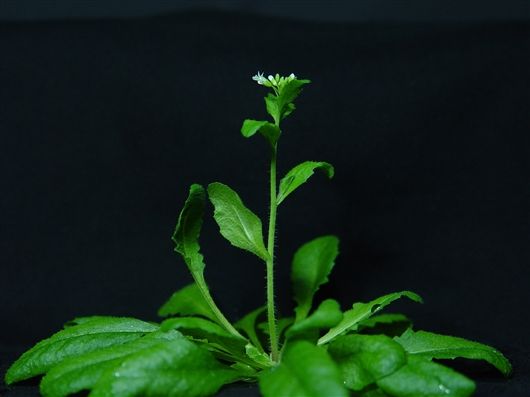Plant Cell:拟南芥WRKY57转录因子研究获新进展
中科院西双版纳热带植物园的研究人员发现,拟南芥WRKY57转录因子参与调控了植物激素JA和auixn所介导的植物叶片衰老信号途径之间的交叉调控通路,并发挥重要的调控功能。相关文章发表于2014年1月份的《Plant Cell》杂志上。

plant Cell:拟南芥WRKY57转录因子研究获新进展
植物叶片衰老受到多种发育因子和环境因子所调控。外源植物激素茉莉酸(JA)处理可以诱导叶片细胞迅速进入衰老程序,而生长素(Auxin)却可以有效地抑制该过程发生。众所周知,植物激素JA和auixn介导的信号途径之间存在着交叉调控通路,并在植物发育和抵抗病原菌侵染等生理过程中发挥着重要调控功能。但是JA和auixn在植物叶片衰老过程中的交叉调控机制及其信号通路,目前尚不了解。
中科院西双版纳热带植物园植物分子生物学组组长余迪求研究员指导的青年研究骨干姜艳娟博士研究发现,拟南芥WRKY57转录因子参与调控了植物激素JA和auixn所介导的植物叶片衰老信号途径之间的交叉调控通路,并发挥重要的调控功能。WRKY57基因的表达分析表明,WRKY57基因显著受JA诱导表达,并在衰老叶片中具有较高的表达水平。JA处理3天和5天后,两个wrky57基因突变体表现出典型的衰老表型,即叶片严重黄化、叶片内叶绿素含量减低和叶片具有更高的细胞死亡速率。
进一步研究表明,一些衰老相关基因(特别是SAG12和SEN4基因)的表达量在wrky57基因突变体内显著增强。染色质免疫共沉淀实验证实WRKY57蛋白可以直接结合到SAG12和SEN4基因启动子上,并抑制了它们的转录水平。此外,体外和体内实验均证明,WRKY57蛋白能有效地与JA信号途径中的抑制子JAZ4/JAZ8和auxin信号途径中的抑制子IAA29之间发生相互作用。与植物激素JA和auxin在分别调控植物叶片衰老的相反功能一致,JAZ4/8和IAA29在JA诱导的叶片衰老过程中也表现出相反的表型,而且JAZ4/8和IAA29蛋白是通过竞争性方式与WRKY57蛋白发生相互作用。
综上所述,研究结果说明了植物激素生长素(Auxin)所介导的信号途径可以通过WRKY57蛋白而拮抗调控茉莉酸(JA)诱导的叶片衰老过程。该课题得到了国家自然科学基金-青年科学基金项目的资助。
原文摘要:
Arabidopsis WRKY57 functions as a node of convergence for Jasmonic acid- and auxin-mediated signaling in Jasmonic acid-induced leaf senescence
Yanjuan Jiang, Gang Liang, Shizhuo Yang and DIQiu Yu
Leaf senescence is regulated by diverse developmental and environmental factors. Exogenous jasmonic acid (JA) can induce leaf senescence, whereas auxin suppresses this physiological process. Crosstalk between JA and auxin signaling has been well studied, but not during JA-induced leaf senescence. Here, we found that upon methyl jasmonate treatment, Arabidopsis thaliana wrky57 mutants produced typical leaf senescence symptoms, such as yellowing leaves, low chlorophyll content, and high cell death rates. Further investigation suggested that senescence-associated genes were upregulated in the wrky57 mutants. Chromatin immunoprecipitation experiments revealed that WRKY57 directly binds to the promoters of SENESCENCE4 and SENESCENCE-ASSOCIATED GENE12 and represses their transcription. In vivo and in vitro experiments suggested that WRKY57 interacts with JASMONATE ZIM-DOMAIN4/8 (JAZ4/8) and the AUX/IAA protein IAA29, repressors of the JA and auxin signaling pathways, respectively. Consistent with the opposing functions of JA and auxin in JA-induced leaf senescence, JAZ4/8 and IAA29 also displayed opposite functions in JA-induced leaf senescence and competitively interacted with WRKY57. Our results suggested that the JA-induced leaf senescence process can be antagonized by auxin via WRKY57. Moreover, WRKY57 protein levels were downregulated by JA but upregulated by auxin. Therefore, as a repressor in JA-induced leaf senescence, WRKY57 is a common component of the JA- and auxin-mediated signaling pathways.

